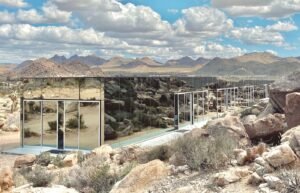It all started with a little hiccup in their off-the-grid paradise. Chris and Roberta Hanley were living it up in their cozy 720-square-foot prefab home nestled in the deserts of Joshua Tree, Calif., when they received the shock of a lifetime – they found out their house was illegal.
It seems that the local government had a little rule requiring homes to be at least 20 feet wide and their little abode just didn’t quite make the cut.
But Chris and Roberta are the type of couple who don’t shy away from a challenge, they saw this as an opportunity to build something even better.
Instead of packing up and leaving, they decided to double down and build a new, legal home that would not only comply with regulations but also exceed their wildest dreams.
And so, they set out to create something truly special, a beautiful off-the-grid home that would make even Mother Nature green with envy.
And that’s exactly what they did, they built their dream home and they lived happily ever after. Talk about turning lemons into lemonade!
The Story
When faced with the daunting task of building a new, legal home, Mr. Hanley, a movie producer and artist, didn’t just roll over and play dead.
No, no, no. He got to work sketching an idea for a new home that would not only comply with local regulations but also blow them away.
He was inspired by the black cuboid monolith in the film “2001: A Space Odyssey” and the work of architect Ludwig Mies van der Rohe, who designed the Seagram Building in New York City, he would later compare the design to an alien life form, or a skyscraper lying on its side.
“I just drew a rectangle on paper and said, ‘OK, we’ll build this,’” recalled Mr. Hanley, 69. “I thought it could just be a monolithic, reflective, ultra-minimal thing.
It’s like when you’re stuck in a creative block, but instead of a blank canvas, I had a blank piece of land and I was going to turn it into a masterpiece”
And that’s exactly what he did, he took a little setback and turned it into a work of art, a true testament of his creativity and resourcefulness.
Talk about taking lemons and making it into a work of art!
The house is a true masterpiece of design and engineering, it was designed with the help of architect Tomas Osinski, and it’s a sight to behold.
This unique home quickly gained fame and popularity in the area, it has been featured on Netflix’s “The World’s Most Amazing Vacation Rentals”, and it has drawn renters including musicians Diplo and Demi Lovato, the Hanleys said.
The house offers an unparalleled experience, it’s like living in harmony with nature, the design allows for maximum natural light and stunning views of the surrounding landscape. It’s a perfect getaway for those seeking privacy and luxury.
This house is not just a property, it’s a work of art, a true testament of Mr. Hanley’s creativity and resourcefulness.
It’s a prime example of how to turn a setback into a masterpiece, and it’s now ready for its new owner to continue its story.
The Invisible House, built by Mr. Hanley, a movie producer, and artist, is a true masterpiece of design and engineering.
The house looks completely different depending on the weather and the time of day. It’s a living, breathing work of art that changes with the environment.
The mirror-like exterior of the house is not just a design feature, but it’s a reflection of the surrounding landscape, making the house blend seamlessly with its surroundings.
Mr. Hanley was inspired by the late artist Andy Warhol, a friend of the couple’s, who famously said, “land really is the best art”.
He wanted to create a home that would be in harmony with the land, and he succeeded. The house is situated on nearly 70 acres abutting Joshua Tree National Park, it’s rectangular in shape, about 225 feet long and spans roughly 5,500 square feet.
One end of the house is cantilevered off the ground on caissons, so it appears to hover above Joshua Tree’s famed rock formations, giving the impression of a house floating on the landscape.
The house is a perfect blend of form and function, it’s a perfect getaway for those seeking privacy and luxury, the design allows for maximum natural light and stunning views of the surrounding landscape.
It’s a unique home that offers an unparalleled experience, it’s like living in harmony with nature. It’s a prime example of how to turn a setback into a masterpiece, and it’s now ready for its new owner to continue its story.
The Invisible House, designed by Mr. Hanley, is a true masterpiece of minimalism and functionality.
The house is intended to feel like one large, floating space, with as few partition walls as possible, Ms. Hanley said.
The open-plan design allows for maximum natural light and stunning views of the surrounding landscape, creating a seamless connection between the interior and exterior.
On three sides of the home, the glass slides open to the outdoors, making it the perfect spot to enjoy the beautiful Joshua Tree National Park.
Between the primary bedroom and the two other bedrooms sits a large, open-plan living area containing a 100-foot-long indoor pool.
Ms. Hanley said they put the pool inside the house as a way to create their “own ecosystem” in the desert, and bring moisture into the house, making it a perfect oasis in the middle of the desert.
The pool is not just a design feature, but it’s a reflection of the couple’s creativity and desire to create a unique living experience.
The cantilevered portion of the house contains the primary bedroom, where a bed sits on a 2,500-pound glass base that took five workers two full days to assemble and install, the Hanleys said.
This feature is not just a design element but it’s also an engineering marvel, it’s like a magic trick, the bed seems to be floating on air.
All the furniture is included in the sale price along with the prefab home, which is still on the property, making it a turn-key operation for the new owner.
The Invisible House is a unique property, it’s a work of art, a true testament of Mr. Hanley’s creativity and resourcefulness. It’s a prime example of how to turn a setback into a masterpiece, and it’s now ready for its new owner to continue its story.
The Aesthetic
In keeping with the minimalist aesthetic, Ms. Hanley said they avoided filling Invisible House with family photographs and personal knickknacks.
Instead, they chose to let the natural beauty of the surrounding landscape take center stage. The focus is on the connection between the interior and exterior, the house becomes an extension of the landscape.
The minimalist design allows the house to blend seamlessly with its surroundings and create a unique living experience. It’s a true oasis in the desert, where the natural beauty is the main decoration.
This approach creates a serene and peaceful environment, perfect for those seeking a private and luxurious getaway.
“I like that it just sort of exists on its own, so I don’t like to throw my clothes all around,” she said. “I wanted it to be a place where your mind [could] drift and you could be inspired.”
Ms. Hanley’s approach to design is not just about creating a beautiful home, but also creating a space that fosters creativity and inspiration.
The minimalist design, the connection to nature, and the absence of personal knickknacks all contribute to creating a serene and peaceful environment.
The Hanleys are connoisseurs of art in various forms, not just architecture and design. Through their company, Muse Productions, they have produced movies such as “The Virgin Suicides,” “American Psycho” and “Spring Breakers”.
They have a keen eye for aesthetics and a passion for creating unique and memorable experiences. The pair met in college in Massachusetts and forged their careers together in Los Angeles.
They also own an architecturally significant home in Lamu, Kenya, where they spent their honeymoon, they said. The Hanleys have a love for unique properties and creating memorable experiences, and the Invisible House is no exception.
The Timeline
Building the property took about six years and millions of dollars, Mr. Hanley said.
The project was a true labor of love, it required not only a significant amount of resources but also a great deal of patience.
It took a year just for the glass to be delivered, he said. The steel beams cost half a million dollars, while the cost of the glass ran close to $700,000, he said. The cost of the project reflects the attention to detail and the use of high-quality materials, the house is not just a property but a work of art.
Mr. Osinski said he and the Hanleys joke that the house took “so much money and so much effort, and you can’t even see it.” The Invisible House is a true testament to the couple’s creativity and resourcefulness, it’s a prime example of how to turn a setback into a masterpiece.
The house was built to be as environmentally sustainable as possible, the Hanleys said. The exterior glass filters ultraviolet and infrared frequencies, and there is a solar thermal system with heating panels for the electricity, pool and hot water.
The house also has an eco-friendly foam roof. The Hanleys care not only about the design and aesthetics of the house but also about its environmental impact. The Invisible House is a true oasis in the desert, not just for the guests but also for the environment.
The Hanleys moved into the house during the Covid-19 crisis, making Joshua Tree their primary home. From the house, the Hanleys said they have seen coyotes, rabbits, hawks, quail and other animals, they have been able to enjoy the natural beauty of Joshua Tree National Park in the comfort of their own home.
They are frequently asked if birds accidentally fly into the house because it blends into the landscape, they said, but they haven’t had any major accidents yet.
A few quail have “bumped into it,” Mr. Hanley said. The house’s design and location allow for a unique and unparalleled living experience, where the guests can enjoy nature in its purest form.
Mr. Osinski said the home allows people to feel protected from the elements but also exposed to them. ‘You are safe, but you can’t hide,” he said.
The Invisible House is not just a property but a work of art, it’s a perfect blend of form and function, it’s a true oasis in the desert, where the natural beauty is the main decoration. It’s a prime example of how to turn a setback into a masterpiece and it’s now ready for its new owner to continue its story.















